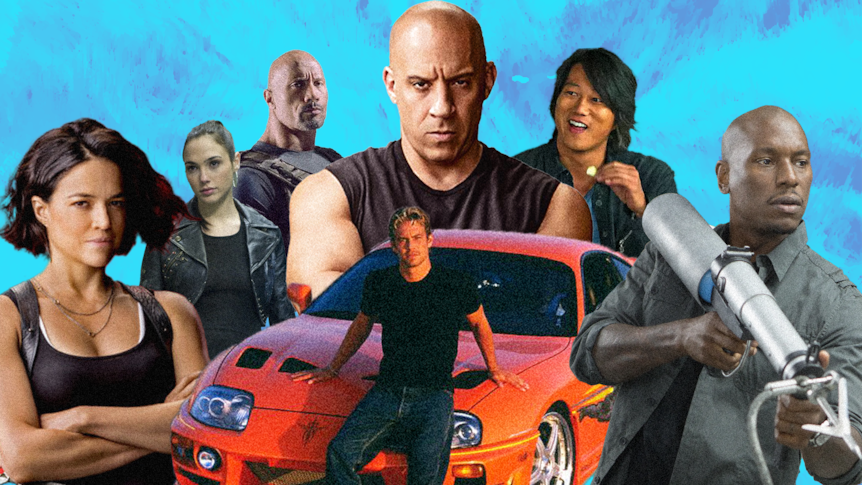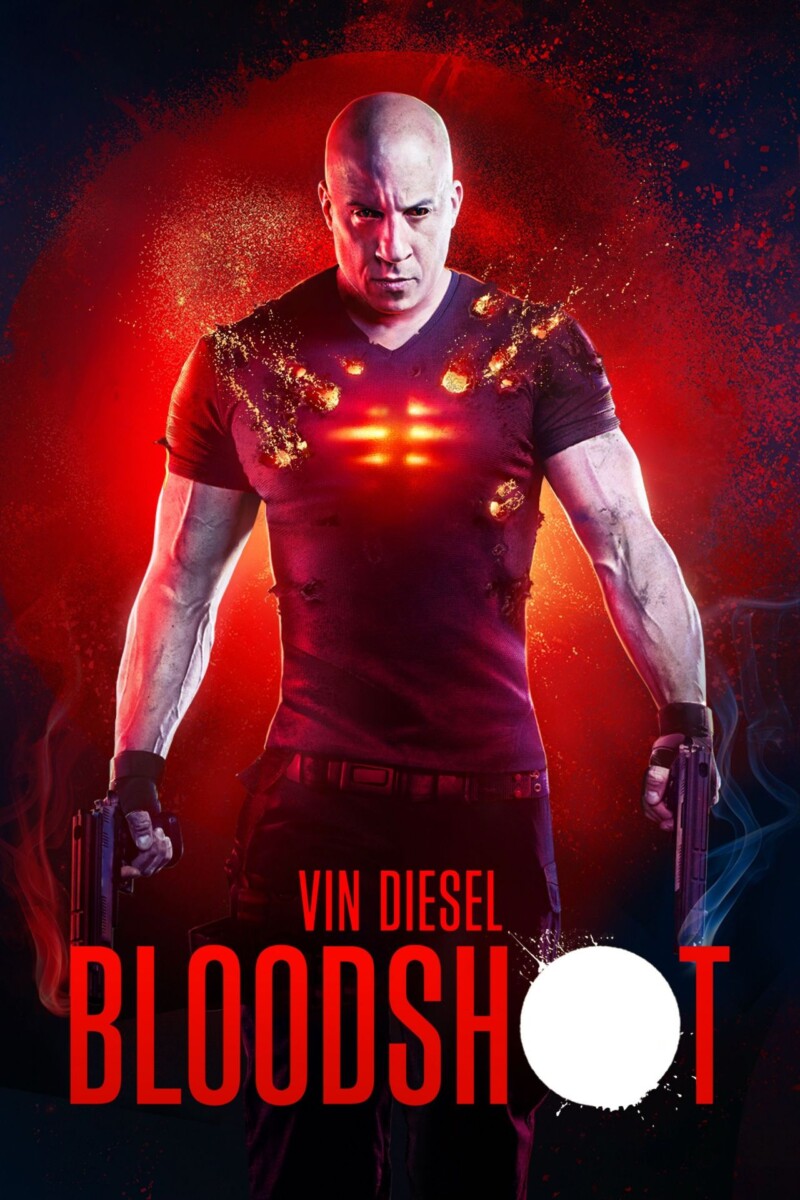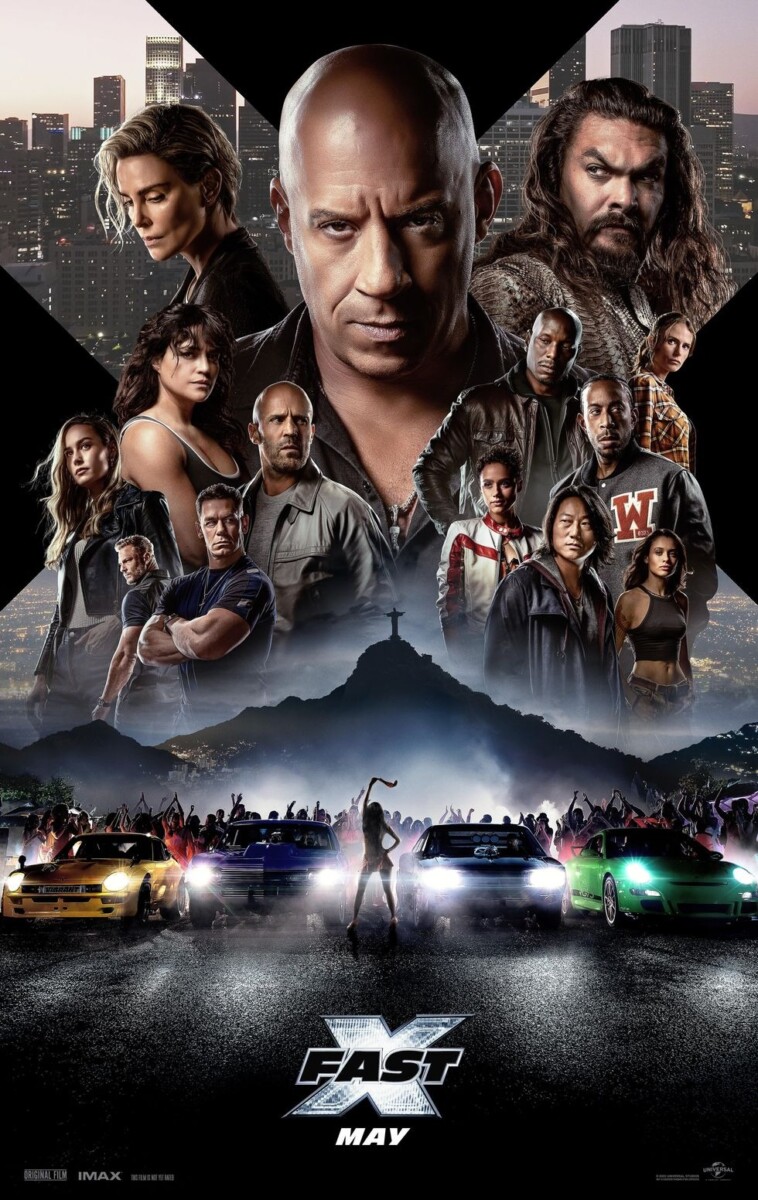20 years of anything is no easy feat. But 20 years of movies about a bald, baritone man with a penchant for fast cars, tank tops and family? Now that’s nothing short of a miracle. As the 10th (!) entry of the Fast and Furious franchise revs into cinemas this week, it’s time to reflect on the cultural impact and evolution of Hollywood’s greatest multi-decade spanning race opera.
Watching 2001’s The Fast and the Furious, in all of its Y2K aesthetic glory, morph into a truly global phenomenon – spawning nine sequels, theme park rides, video games and over $6 billion USD in box office takings – has been nothing short of fascinating. And as for its 10th iteration, the series’ main cast features no less than four Oscar winners (Helen Mirren, Brie Larson, Charlize Theron and Rita Moreno).
At the centre of it all: Vin Diesel. Equal parts Tom Cruise and Tommy Wiseau, Diesel’s presence has been crucial to the success of the series. His seemingly endless supply of passion for life itself (just take a look at his Happy Creative Sundays series on Instagram if ever you’re feeling uninspired) has been instrumental in transforming the Fast series into a multi-billion dollar tent pole franchise.
Watching his character, the monosyllabic Dominic Toretto go from anti-hero to legitimate superhero has been legitimately enthralling. By all accounts, it shouldn’t work. But here we are, 22 years after Dom Toretto first mumbled that he lives his life “a quarter mile at a time.”
Now that the franchise has hit double digits, it’s the perfect time to look back on the highs and lows of the series and rank the movies – from worst to best. As a mega fan this isn’t a task I take lightly (I watched all 10 in the span of four days to ensure zero recency bias) All Fast & Furious films are certified bangers in their own unique way – some are more Fast and more Furious than others.
So buckle up and strap yourself in for a confusing timeline, characters returning from the dead, endless retcons and above all: family.
Director: Justin Lin
Release order: 4
The coldest instalment in the Fast canon, Director Justin Lin’s second lap around the block is a necessary course correction after the (mostly) Vin-free second and third chapters. The success of the original film owes itself to the budding bromance between Vin Diesel and Paul Walker’s Dominic Toretto and Brian O’Connor – so reuniting the pair after three films is by far and above the best thing about this.
Dour (RIP Letty) and surprisingly grounded for a usually bombastic series, F4 exists in a kind of Fast limbo – with one foot in the series’ rear view (street racing) and the other firmly in its future (belief-suspending heists). At best, it’s the perfect prologue for what’s next: the necessary evolution of the franchise that took it to outrageous new heights.
Best Moment: the very-much-dead-in-the-last-film Han being very much alive now – the first indication that even the chronological order of the films wasn’t safe from the laws of logic.
Vital Lore Contribution: Reuniting the familia.
Director: Louis Leterrier
Release Order: 10
The overstuffed and uncharacteristically charmless 10th F&F entry feels like the first victim of the 2023 writers’ strike even though it was penned over a year ago. The entire thing feels like it’s been made by Chat GPT prompts. While all of the hallmarks that have defined the franchise are on full display here: retconning previous films, former foes playing nice with Dom & Co., beloved characters returning from the dead, excessive use of the word “family” – there’s a distinct lack of goofy soul that has been the series’ secret weapon this side of a NOS canister.
The “I can’t believe they’re spies now!” sheen that has defined the latter half of the series has completely worn off. Once upon a time, Fast characters would openly react to how absurd their remit has become. Now, it’s just par for the course. At this point the most shocking stunt they can do now is go back to stealing DVD players.
One of the defining traits of the series has been its insistence on outliving its intended shelf life, but Fast X is the first time it really feels like there’s no gas left in the tank. The franchise has always been clever about how stupid they were; knowingly toeing the line between melodrama and actual drama while constantly winking at the audience. This time around, it just feels straight up stupid.
Yes, complaining that the Fast series is too stupid is like complaining that Corona tastes like beer. But besides series newcomer Jason Momoa as the outrageously campy big bad, Dante Rayes (retconned son of the baddie from Fast Five), Fast X feels as though it’s being performed by deepfaked versions of the actors barely going through the motions. Much like the zombie-car sequence from Fast 8 – there’s nothing behind the wheel.
But as this list will go on to show, the Fast series has time and time again proved that if anything, it’s resilient and not adverse to tweaks and reinvention. Here’s hoping there’s a chance the Familia can find their lead-footing again.
Best Moment: Dom and his crew pinball a giant rolling bomb throughout Rome in an attempt to prevent it blowing up the Vatican.
Best Lore Contribution: The addition of Jason Momoa, the first character who could be aware that he’s in a Fast & Furious movie.
Director: F. Gary Gray
Release Order: 8
Fast 8 had the impossible task of continuing the series at its cultural peak while simultaneously dealing with the blue eyed elephant in the room: the absence of the late Paul Walker. But rather than pause for reflection, F8 completely drifts past all story logic and ups the series’ already Himalayan-sized stakes. Enter: new recurring big bad, the evil hacker Cipher (Charlize Theron), who bribes Dom into betraying his crew and join her crew of terrorists by threatening to take away the very thing that defines him: family.
The eighth Fast episode continues the previous film’s trait of an antagonist joining the crew, leading to the clear highlight of F8: Luke Hobbs’ and Deckard Shaw’s testosterone fuelled rivalry, which sees Dwayne Johnson and Jason Statham trading barbs with such macho ease that it warranted its own spin off (not ranked, but would probably be last).
Despite the odds, it’s a miracle that director F. Gary Gray makes the film work as well as it does. While F8’s features some of the series best and bombastic sequences (rescuing a baby from a moving plane, zombie cars in NYC, every scene Charlize Theron’s dreadlocks are in) its legacy will be defined by what’s missing: Paul Walker.
Best Moment: The Rock’s Hobbs literally changes the direction of a torpedo with his hand while leaning out of a speeding vehicle in a Russian snowfield.
Vital Lore Contribution: The addition of Helen Mirren as the Shaw brothers’ mum, ‘Queenie’.
Director: John Singleton
Release Order: 2
Put it down to Vin Diesel’s refusal to return, but the first Fast sequel has an uncharacteristic mean streak that’s notably AWOL throughout the rest of the series (torturing someone via a hungry rat in a bucket isn’t very Family of you).
Set amongst the hazy palette of Miami, 2 Fast not only introduces us to extremely liberal usage of the affectionate terms ‘cuh’ and ‘breh’, but future series’ mainstays Tej Parker (Ludacris) and Roman Pierce (Tyrese Gibson). F2 may feel more like a side quest than a proper chapter – but it’s essential in proving that the Fast franchise was more than a flash in the pan.
A few years ago, I would have ranked this dead last but there’s something charming about its early Y2K aesthetic that’s aged like a fine wine, or Corona (see: Suki’s (Devon Aoki) hot pink Honda S2000 and fully accessorised wardrobe).
Best Moment: Roman’s NOS powered ejector seat, “ejecto seato cuz!
Vital Lore Contribution: Its oft-parodied title alone has contributed more to society than most other films could ever hope to.
Director: Justin Lin
Release Order: 9
The Fast series somehow manages to overtake its own telenovela (and stratospheric) heights on its 9th lap, with more canonical retcons than a failing comic book publisher. At this point in the series, it’s best to just accept the fact that Dom and his team are essentially immortal – heck, even the team reference their tendency to evade danger completely unscathed in a handful of very meta moments.
While F9 serves up some absolute plot doozies, even by Fast standards – Han is in fact, not dead; going to literal space in a car – it somehow manages to never completely jump the shark, maintaining a semblance of a human pulse that’s completely absent in Fast X.
In fact, the hardest concept to grapple isn’t seeing the familia use NOS in actual outer space, or the magnet truck car chase – but that for a man who claims that there is nothing more important than family, we’re only now learning about Dom’s long lost younger brother Jakob (John Cena) who just also happens to be a spy who specialises in 4 wheel espionage.
Best Moment: Roman and Tej go to space in a Pontiac Fiero. Enough said.
Vital Lore Contribution: The second retcon in the span three films to Han’s supposed death in Tokyo Drift.
Director: Justin Lin
Release Order: 6
A pivotal entry in the modern day Fast lore, the sixth instalment establishes the new norm for the Fast Familia. Long gone are the days of heists and street racing. Armed only with Family and a bucket of Corona, Dominic Toretto and his crew are recruited by the US government to assist in bringing potential world-ending threats in exchange for amnesty for their previous crimes. I’m not questioning it, and you certainly shouldn’t either.
Fast 6’s greatest asset is how it completely dives headfirst into the series’ telenovela tendencies. Not only is there an amazing amnesia subplot involving the return of Dom’s former flame Letty (Michelle Rodriguez) from the literal grave, but the opening credits serve as a literal ‘previously on The Fast & Furious’ sequence to help bring you up to speed.
In addition to showcasing the world’s longest airport runway for a completely ridiculous action sequence in which the Family prevent a plane taking off by harpooning it (NOS powered, of course), F6’s greatest legacy is that it’s the first instance of previous antagonists being anointed as Family.
Best Moment: Dom diving and subsequently catching Letty mid air, post vehicle collision on a bridge after being chased by a tank. Hell yeah.
Vital Lore Contribution: A post credit scene revealing that Tokyo Drift is now actually set between 6 and 7.
Director: Justin Lin
Release Order: 3
It’s impossible to read the title of the third (or 6.5th) Fast entry without hearing the hook to Teriyaki Boyz’ iconic titular track: “I wonder if you know how they live in Tokyo” blaring in your head.
A major detour from the first two entries, Justin Lin’s Fast debut is an outlier for many reasons, namely: it’s the only film to not feature Diesel or Walker in the lead. Tokyo Drift holds the distinction of having both the least convoluted story in the series (highschooler Sean is sent to live with his father in Tokyo and learns to drift) AND the least charismatic leading man of all time (Lucas Black).
Lin’s stylish visual flair that would help resuscitate the series is on display here. Tokyo proves to be the perfect neon backdrop for the series, proving that Fast could go international. Plus, the soundtrack goes harder than any other entry.
Best Moment: Dominic Toretto popping up in the final scene (though he only agreed to it to get the rights for his Riddick character), connecting the series.
Vital Lore Contribution: the introduction of the only actual cool person in the franchise, Han.
Director: Rob Cohen
Release Order: 1
The opening Fast chapter tells the comparatively grounded story of an undercover cop infiltrating an illegal LA street racing crew who use their disdain for road rules and enforced speed limits to perform highway heists. Yes, the series that would eventually wind up in outer space started out small: knocking off DVD players from the back of trucks.
What is there left to say about the first Fast? It’s the Rosetta Stone of the Fast ethos: family, Coronas, saying grace, NOS, death defying stunts, living life a quarter mile of a time – it’s all here folks.
In lesser hands, The Fast and the Furious it would be best remembered as a Monster Energy fuelled re-imaging of Point Break with a coat of Von Dutch destined to a life in Buy 2 Get 1 Free DVD bin purgatory. But director Rob Cohen finds the sparkplug of the series – Dom and Brian’s bromance – and hones in on it – cracking the Fast formula: one part RPM, one part: goofy earnestness
Best sequence: Hard to pick, but Dom and Brian’s first race. “I almost had you dude.”
Vital Lore Contribution: Literally E V E R Y T H I N G.
Director: James Wan
Release Order: 7
It’s impossible to consider Fast 7 in a vacuum ignoring the tragedy that surrounded its production: Paul Walker’s untimely death before filming had wrapped. Yet against all odds, F7 manages to become perhaps the quintessential Fast entry: full of spectacle, stakes and an emotional ending that guarantees not an eye remains dry.
Despite the real world tragedy, Furious 7 charges full steam ahead with the introduction of the crew’s greatest villain: Jason Statham’s seemingly unstoppable Deckard Shaw, who’s hellbent on revenge after the crew took down his brother in the F6.
F7 hands down contains the most air-punchingly fun sequences in all of the films. From the crew car-skydiving from a plane crashing through three Abu Dhabi skyscrapers mid-air in a convertible with no brakes, to The Rock literally flexing out of his arm cast (“Daddy’s gotta go to work”) – but nothing compares to the most impressive stunt at all: the emotional in-film and real life send off to Brian O’Connor/Paul Walker. For a series defined by its melodramatic tendencies, opting to keep Brian alive in-universe, bowing out quietly to raise a family is peak Fast performance.
Best Moment: It’s sacrilege to say anything other than Paul’s farewell, but the skyscraper sequence is a close second.
Vital Lore Contribution: For Paul.
Director: Justin Lin
Release Order: 5
While F7 may be the best Fast film, 2011’s Five Five holds the distinction of being the best film film of the series. It functions so well on its own accord, it can be enjoyed as a soft-reboot to the saga despite its middle placement in the series.
A true cultural reset, F5 is the exact moment you can pinpoint the Fast series upping their own ante, resulting in a complete franchise glow up: the transformation from small-time street racers into a crew of NOS-powered Danny Oceans. Around the time of release, The Rock famously called himself “franchise viagra”, implying that his inclusion was the reason Fast Five was such a commercial and critical success. But there’s much more in addition to his sweaty presence that makes Fast Five the best of the series.
Despite the larger scale, there’s still a semblance of groundedness to the action. This was before anyone came back from the dead, so there’s some actual stakes here! A bank heist in Rio sounds outright quaint compared to the utter ridiculousness that will follow in future chapters.
It’s paced well, looks great (before an over-reliance on green screens) but Fast Five’s greatest quality is how it retroactively enhances the films that came before it. What was once fractured now has a connective through line. It may have taken ten years, but Familia got there. The sheer joy of seeing all of the separate players from the previous films get the call up to join Dom’s crew? Now that’s FAMILY.
Best Moment: The entire safe heist sequence is i-c-o-n-i-c. The reveal of the safe switch? That’s the Corona on top.
Vital Lore Contribution: The absolute franchise glow up. Not that what became it was dud, but the ease at which F5 recontetxualised the scatterhsot lead up is top gear.




